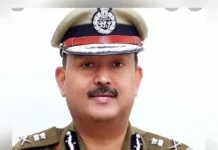[ Rhea Panicker ]
Rhea Panicker: What are the primary types of natural disasters that Arunachal Pradesh is most vulnerable to, and how is the state preparing for them?
Dani Sulu: Firstly, floods and landslides are the most commonly recurring problems here, and most of the deaths are also caused by them. Besides that, Arunachal is very prone to natural disasters, being in Seismic Zone 5, so we also prepare for earthquakes. Fire incidents are also not uncommon here.
Since Arunachal is so vulnerable to these disasters, we have been working efficiently and effectively to manage it. We cannot prevent disasters, but we can take precautions and create awareness. We have State Disaster Response Force units in five locations: Bomdila, Ziro, Pasighat, Tezu and Khonsa. In cases of emergencies, these forces rush to the scene and carry out search and rescue operations. We also have a unit of the 12 Battalion NDRF in Doimukh, from where we dispatch teams to different parts of the state whenever required.
In April, we carry out pre-monsoon awareness campaigns. We have meetings with stakeholders, deputy commissioners, and departments like medical and education, cautioning them and asking them to be prepared. We also publish information in newspapers and on social media, as well as create jingles made up of ‘dos and don’ts’ to share with the general public.
Additionally, we have the state emergency operation system, which is available to everyone 24/7. Whether it be morning or night, in case of any natural disaster the SEOC will carry out its duties.
RP: Can you provide examples of recent disaster responses in Arunachal and what lessons were learned from those events?
DS: Although this year we haven’t had many naturaldisasters, I would like to refer to an event that happened last year. We had a major landslide in the capital region. All the places vulnerable to landslides were near the riversides. Unfortunately, three people lost their lives because they lived near the highway, in a danger zone, and heavy rain caused half the hill to collapse onto their house.
We had repeatedly asked them to vacate the area, but they had refused to.
From this incident, we learned that people often refuse to move, even when there is impending danger. It takes a lot of persuasion from our side to relocate them to safe zones. We have also cautioned the district administration and emphasised on the safety of the roads and buildings.
RP: What are the primary challenges faced during disaster response in remote and difficult-to-accessareas of Arunachal?
DS: Although we have highways connecting to district headquarters, geographically Arunachal is a big state. During the monsoon season, many remote places lack roads and connectivity. Reaching people in these remote places poses a big challenge. To tackle this, we have the district emergency operation centre, which connects all the districts and circles.
We also carry out trainings. Every year, more than two batches are conducted, training 10-20 people from each constituency. This creates a pool of resource persons who can respond quickly. By doing it, we raise awareness in rural areas.
RP: How does the disaster management team coordinate with other agencies, such as the health department, to manage heatwaves?
DS: Just as we prepare for the monsoon in the month of April, as soon as summer advances, we bring out our guidelines on heatwaves. We have had around 3-4 meetings with the government of India and the state government to receive the dos and don’ts of heatwaves. At the state level, we then hold meetings with the district administration, the education department, the health department, and the power department, issuing clear instructions on how to handle heatwaves.
We have been doing this for years now. When compared to other states, Arunachal faces fewer problems concerned with heatwaves. However, we still carry these out as precautions. The maximum we have faced so far on record is 40 degrees, it is still less compared to places like Delhi and Chennai. Our major concerns remain floods and landslides.
RP: Floods and flashfloods have become annual occurrences. What specific strategies are being employed to manage and reduce the impact of these floods?
DS: Flashfloods are a significant concern for Arunachal. Unlike the land flooding in Assam, which results in water levels rising and inundating the houses and fields, heavy rain in Arunachal causes water to run, taking the soil with it.
This also becomes a future catalyst for landslides. To address these issues, we have data and early warning systems in place. Disaster prone areas are identified. Prevention is challenging because Arunachal is geographically extensive. Along the roadsides, the PWD and the water resources department carry out necessary works.
RP: Does the state plan to address the recurrent issue of erosion of fertile agriculture and horticulture fields due to flooding?
DS: Yes. There are lots of plantation problems and they are taken up by the agriculture department, horticulture department and even the rural development department. They identify the vulnerable places and carry out planting. They also discourage jhum cultivation.
RP: Are there any ongoing or planned initiatives to stabilise slopes and reduce soil loosening caused byfrequent minor tremors?
DS: Soil stabilisation activities are often carried out, especially around Zero areas, by the highway department. The soil conservation department also looks into these aspects and is purely into it.
In case of debris caused by tremors, the departments concerned clear it. If it is near the highway, the highway department handles it; otherwise, the respective departments take care of it. These efforts include both soil stabilisation and debris clearance by the departments concerned.






